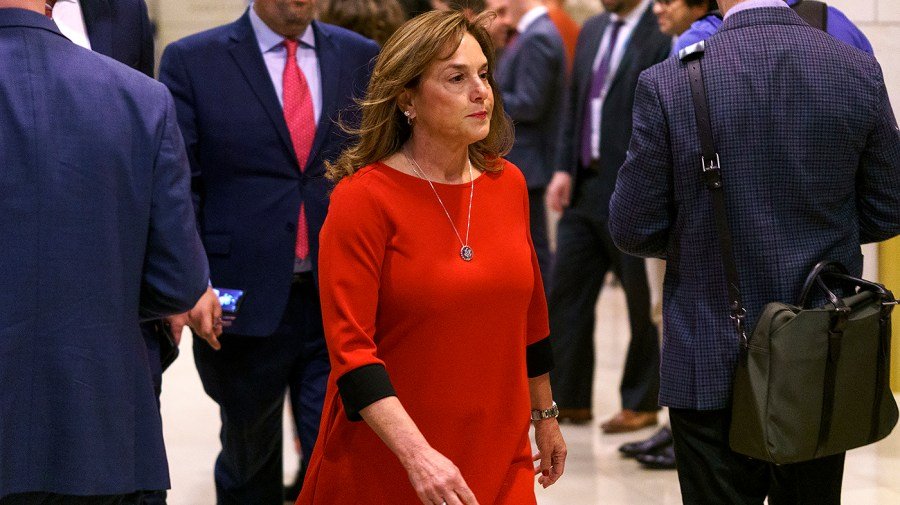World News
House GOP grows skeptical on Ukraine: ‘It’s not just the Freedom Caucus’ on September 15, 2023 at 9:30 am

Skepticism is growing among House Republicans on the approval of more Ukraine funding as Congress faces its first test on America’s role in the war against Russia.
The House could face a vote as soon as this month as the Senate looks to fold a Ukraine aid package into a continuing resolution that would push back the deadline for a potential government shutdown.
While a minority wing of far-right lawmakers have long opposed more Ukraine funding, several GOP lawmakers told The Hill this week that more moderate House Republicans are also raising concerns.
“It’s not just the Freedom Caucus; I think there’s a lot of people that are concerned with funding,” said Rep. Lisa McClain (R-Mich.), a member of the House Armed Services Committee. “I think it all depends on what’s in the bill.”
McClain said she wanted Congress to focus the spending bills on keeping the federal government running and on domestic crises like the recent wildfires in Hawaii.
“We have the appropriations bills right that we need to get out,” she said. “That is super critical. But also what I’m more concerned about is disaster relief for the United States. That’s what our focus is on right now.”
Rep. Andy Biggs (R-Ariz.), a former chair of the House Freedom Caucus, said he would not support a new Ukraine package and doubted any Ukraine funding would be moving to the floor anytime soon.
But he was hesitant to say the opposition would ultimately have enough votes to stop approval of Ukraine aid.
“We’ve got a lot of war hawks in Congress,” he said, “so I’m not sure.”
Though the Republican opposition to U.S. military support for Ukraine has steadily grown over the past year and a half of the war — both in Congress and among voters — a majority of the GOP caucus and almost all Democrats have overwhelmingly passed previous spending packages for Kyiv.
But the next vote on Ukraine aid will be the first on a major package since Speaker Kevin McCarthy (R-Calif.) took the gavel promising no more “blank checks” to Ukraine.
The uneasiness in the House comes as the Senate plans to include Ukraine funding in a continuing resolution (CR) to keep the government funded as annual appropriations bills are worked out.
If the House refuses to pass a CR with the Ukraine funding attached, it could be punted to later this year and attached to other spending bills or considered on its own.
Punchbowl News reported this month that McCarthy does not want Ukraine funding in a CR but will move to pass it as a separate supplemental — but only if he wins additional funding for the border.
Congressional action is in response to President Biden’s August request for $24 billion to support Ukraine, including $13 billion in security assistance. Biden included the request as part of a $40 billion package that includes disaster relief funds.
The House is also ensnared in an impeachment inquiry into Biden, which may impact the spending talks.
Rep. Nancy Mace (R-S.C.), an Armed Services Committee member, said the House has “a lot of other issues ahead” of Ukraine funding.
“Additional funding for Ukraine is going to be difficult to sell to the American people because every day that we go on fewer Americans support the war in Ukraine,” she said.
A CNN poll in August found a majority of Americans, 55 percent to 45 percent, oppose more aid to Ukraine, though that is split on party lines. About 71 percent of Republican respondents said the U.S. should not provide additional funding, according to the poll, while 62 percent of Democrats back more funding.
Other polls, including a Reagan Institute poll over the summer, have indicated stronger support. An August Fox News poll found a growing number of Americans were skeptical of backing Ukraine but the plurality, or 40 percent, said support should stay the same.
The debate comes at a critical moment for Ukraine, which is struggling to gain ground in its counteroffensive launched earlier this summer and will need a steady supply of weaponry and equipment to stay in the fight.
Congress approved $113 billion in total aid for Ukraine last year, about $47 billion of which translated directly to supporting Ukraine’s military needs.
But that pool of money is running out fast. It’s unclear how much money is left exactly because of the Pentagon’s massive accounting errors, but publicly available data shows about $44 billion has been spent so far, leaving just a few billion left.
It’s not only Democrats who are pressuring the House GOP to get on board with new funding.
Senate Minority Leader Mitch McConnell (R-Ky.) said on the floor this month that skeptics of Ukraine aid were making “faulty arguments,” arguing the war was worth funding.
“Standing with our allies against [Russian President Vladimir Putin] is directly and measurably strengthening the U.S. military,” he said. “Our support to Ukraine is grinding down one of America’s biggest strategic adversaries.”
Since taking over the House in January, there has been a persistent fear among Ukraine’s supporters that Republicans will stymie more aid.
That bubbled to the surface in July, when 70 Republican lawmakers supported a failed bid to insert an amendment in a draft version of the annual defense bill that would have cut off all U.S. military funding to Ukraine.
Republican presidential candidates such as entrepreneur Vivek Ramaswamy and former President Trump are also giving voice to the growing skepticism showing up in polls.
There’s also concern that Ukraine could be a casualty of McCarthy’s fraught relationship with the Freedom Caucus, which released a list of demands in August in order for members to back the spending bills. One of those positions was outright opposition to “any blank check for Ukraine in any supplemental appropriations bill.”
Rep. Warren Davidson (R-Ohio), a Freedom Caucus member, said he was hopeful McCarthy would keep Ukraine funding off the floor entirely.
“We have other things that we need to resolve,” he said. “ The House needs to stay focused on funding the government.”
Davidson wrote Thursday on X, the platform formerly known as Twitter, that he will oppose any future aid package to Ukraine “until the Biden administration provides Congress with a clear mission” in the war.
The Biden administration maintains that it has been clear on its goals in Ukraine.
White House national security adviser Jake Sullivan told reporters Wednesday that he doesn’t “know how many times I’ve answered this question in the last year and a half.”
“We want to see Ukraine succeed on the battlefield. We want to see them get all their territory back. We want to see their sovereignty respected,” Sullivan said. “We want to see no Russian troops inside Ukraine. We want to see the war end.”
“And it could end today, obviously, if Mr. Putin would do the right thing and just get the hell out,” he added. “That’s clearly not going to happen right now.”
Skepticism is growing among House Republicans on the approval of more Ukraine funding as Congress faces its first test on America’s role in the war against Russia. The House could face a vote as soon as this month as the Senate looks to fold a Ukraine aid package into a continuing resolution that would push…
Politics
Netanyahu’s UN Speech Triggers Diplomatic Walkouts and Mass Protests

What Happened at the United Nations
On Friday, Israeli Prime Minister Benjamin Netanyahu addressed the United Nations General Assembly in New York City, defending Israel’s ongoing military operations in Gaza. As he spoke, more than 100 delegates from over 50 countries stood up and left the chamber—a rare and significant diplomatic walkout. Outside the UN, thousands of protesters gathered to voice opposition to Netanyahu’s policies and call for accountability, including some who labeled him a war criminal. The protest included activists from Palestinian and Jewish groups, along with international allies.

Why Did Delegates and Protesters Walk Out?
The walkouts and protests were a response to Israel’s continued offensive in Gaza, which has resulted in widespread destruction and a significant humanitarian crisis. Many countries and individuals have accused Israel of excessive use of force, and some international prosecutors have suggested Netanyahu should face investigation by the International Criminal Court for war crimes, including claims that starvation was used as a weapon against civilians. At the same time, a record number of nations—over 150—recently recognized the State of Palestine, leaving the United States as the only permanent UN Security Council member not to join them.
International Reaction and Significance
The diplomatic walkouts and street protests demonstrate increasing global concern over the situation in Gaza and growing support for Palestinian statehood. Several world leaders, including Colombia’s President Gustavo Petro, showed visible solidarity with protesters. Petro called for international intervention and, controversially, for US troops not to follow orders he viewed as supporting ongoing conflict. The US later revoked Petro’s visa over his role in the protests, which he argued was evidence of a declining respect for international law.

Why Is This News Important?
The Gaza conflict is one of the world’s most contentious and closely-watched issues. It has drawn strong feelings and differing opinions from governments, activists, and ordinary people worldwide. The United Nations, as an international organization focused on peace and human rights, is a key arena for these debates. The events surrounding Netanyahu’s speech show that many nations and voices are urging new action—from recognition of Palestinian rights to calls for sanctions against Israel—while discussion and disagreement over the best path forward continue.
This episode at the UN highlights how international diplomacy, public protests, and official policy are all intersecting in real time as the search for solutions to the Israeli-Palestinian conflict remains urgent and unresolved.
News
Is a Nuclear-Powered Alien Spacecraft Flying Toward Earth?

A mysterious interstellar object speeding through our solar system has reignited debates about extraterrestrial technology — and whether Earth might currently be under quiet observation.
The object, known as 3I/ATLAS, is only the third confirmed interstellar visitor ever detected. Unlike ordinary comets, however, this cosmic traveler has baffled astronomers with its unusual brightness, strange trajectory, and lack of a visible cometary tail. While most scientists cautiously describe it as a natural body, one leading astrophysicist believes something much stranger is at play.

Harvard Scientist’s Bold Claim
Professor Avi Loeb of Harvard University, head of the Galileo Project, has suggested that 3I/ATLAS may in fact be a nuclear-powered alien spacecraft designed to test how humanity would respond to an interstellar visitor. He argues that its flight path is improbably precise, bringing it close to Mars, Venus, and Earth — a pattern highly unlikely to occur by chance.
Loeb also points out that telescope images show a glow inconsistent with ordinary dust behavior. Instead of trailing behind like a comet, the halo-like light appears to extend in unusual ways, sparking debate about whether the object could be emitting energy of its own.
Headed Toward Earth’s Neighborhood
3I/ATLAS is expected to make its closest approach in late 2025, passing near Mars before swinging by the inner solar system. Although Earth itself will be on the opposite side of the Sun when it comes closest, the alignment will still enable space-based observatories to capture sharper data.

Loeb has called on NASA and other agencies to use spacecraft already stationed near Mars or Jupiter — including the Juno mission — to take high-resolution photographs. He believes such efforts could reveal whether the interstellar object is truly natural, or the first technological probe humanity has ever encountered.
Should We Be Worried?
While most astronomers argue caution before jumping to alien conclusions, Loeb insists that scientific openness is key. “If it’s just a comet, we learn something new,” he said. “But if it’s a spacecraft, it would be the most important discovery in human history.”
For now, 3I/ATLAS remains a mysterious speck on astronomers’ charts, drifting closer with each passing day. Whether it proves to be a frozen remnant of another star system or something far more advanced, the interstellar visitor has already succeeded in one mission: reminding us how vast and unpredictable the universe really is.
News
AI Automation Could Cause Up to 20% Unemployment—A Workforce on the Brink

Stark Warning from Anthropic CEO Highlights Rapid Job Displacement Risk
The looming threat of widespread unemployment due to AI automation has sparked intense debate among experts, business leaders, and policymakers. Dario Amodei, CEO of Anthropic—the company behind the influential AI language model Claude—issued a stark warning that has sent shockwaves through corporate America:

“Up to half of all entry-level white collar jobs could disappear within the next one to five years, potentially pushing unemployment rates as high as 20% during this period.”
This dramatic forecast paints a picture of a rapid and unsettling transformation in the workforce, driven by AI technologies that can perform complex cognitive tasks.
Balancing Predictions: Worst-Case Scenarios vs. Moderate Impact
However, this forecast represents one end of a spectrum of expert predictions. While Amodei’s warning highlights the worst-case scenario driven by the swift adoption of AI agents capable of coding, analyzing data, drafting legal documents, and managing workflows around the clock, other analyses suggest a more moderate impact. For example, Goldman Sachs estimates that AI could temporarily displace about 6-7% of U.S. jobs, with unemployment rising by approximately half a percentage point during the adjustment period. Their research anticipates a more gradual transition with a mixture of job disruption and creation.

The Unprecedented Speed and Scope of AI-Driven Job Disruption
The truth likely lies somewhere in between. AI is advancing at unprecedented speed, and the scope of jobs affected spans far beyond blue-collar roles to white-collar positions that required college degrees and years of training. Entry-level roles such as customer service representatives, data entry clerks, junior analysts, and administrative assistants face the greatest near-term risk. Mid-level roles in accounting, marketing, law, and engineering could soon follow, with companies already laying off workers citing AI-driven efficiencies.
Preparing for an AI-Transformed Workforce: Adaptation Is Essential
Ultimately, the AI-driven job transformation is no longer a distant prospect but unfolding now. Whether unemployment spikes to 20% or stabilizes at lower levels depends on many factors, including business adoption rates, government policies, and the ability of workers to reskill. What is certain is that the workforce of tomorrow will look very different from today—and the time to prepare is right now.

 Entertainment4 weeks ago
Entertainment4 weeks agoJudge Sends Diddy to Prison for 50 Months

 News4 weeks ago
News4 weeks agoHow Digital ID Is Becoming Everyone’s New Gatekeeper

 Business4 weeks ago
Business4 weeks agoWhy 9 Million Americans Have Left

 Health3 weeks ago
Health3 weeks agoWhy the Fertility Cliff at 35 Is Mostly a Myth

 Health3 weeks ago
Health3 weeks agoWhy Gen Z Opted Out of Parties—and What It’s Costing Them

 News3 weeks ago
News3 weeks agoWhat Hollywood Gets Dead Wrong About Witness Protection

 Health3 weeks ago
Health3 weeks agoOver Half of Americans Use PTO for Pure Rest, While 1 in 3 Do Nothing for Days

 News3 weeks ago
News3 weeks agoBad Bunny Makes History – and Headlines – As Super Bowl Halftime Choice































